Mid-early carrot variety with a high carotene content: Children's sweet
One of the important vegetables in the baby's diet is carrots. It is especially useful raw. To attract the child's interest in this bright crispy vegetable, breeders are constantly improving carrot varieties, increasing the content of carotene and sugar. One of the representatives of such varieties is children's sweetness carrot.
The content of the article
Description of the variety of carrots Children's sweetness
Baby sweetness belongs to medium early varieties... Sowing is done in late April - early May. Carrots can withstand temperatures as low as -4 ° C. Ripening period - 110-130 days. Root vegetables are rich orange, sweet, juicy, crunchy. The variety has high yield rates - 286-371 c / ha.
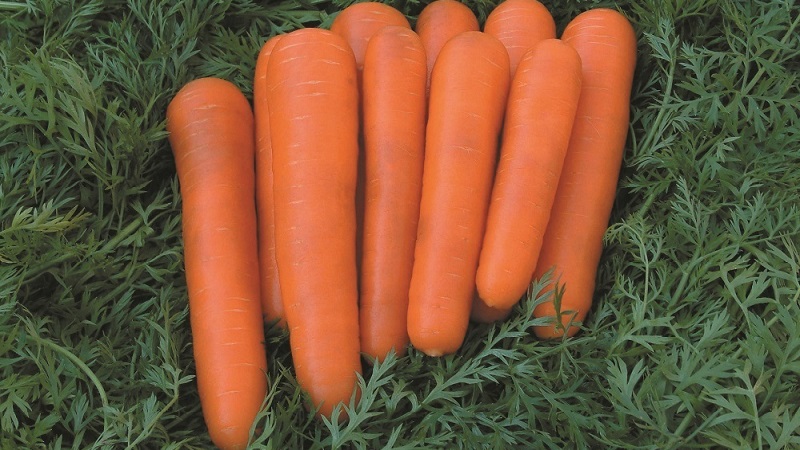
The variety can be sown before winter... Sowing is carried out after the temperature drops to + 5 ° C, usually in late October - early November.
Variety used for the preparation of children's juices, puree.
Other "baby" varieties
Breeders have developed many sweet varieties of carrots. One of them - carrots Children's joy... It grows smaller than Sweetness, but they have the same taste.
Variety Children's - mid-season with a high content of vitamins PP, C, E, K, B, A. Harvest - sweet and juicy roots with a small core.
Children's vitamin - mid-season variety. Recommended for fresh use and for winter storage. The mass of root crops is 95-130 g.
Sweet tooth - one of the best sweet varieties, late ripening, ripening period - 4 months. Contains an increased amount of saccharides and provitamin A.
Origin and development
Carrot variety Children's sweetness created by breeders based on the variety Amsterdam.
is he part of annual plants of the Berlikum cultivargiving root crops during one season. When planting root crops for the second season, active growth will occur only at the tops, followed by flowering and ripening of the seed.
Chemical composition and useful properties
100 g of raw carrots contains: fructose - 12%, dry matter - 12.7-14.1%, beta-carotene - 20.8 mg. The energy value of one root crop is 34.5 kcal.
The content of macronutrients in root crops (per 100 g):
- potassium - 225 mg;
- calcium - 24.6 mg;
- phosphorus - 52 mg;
- magnesium - 37.4 mg;
- sodium - 18.4 mg;
- sulfur - 4.5 mg.
Trace element content (per 100 g):
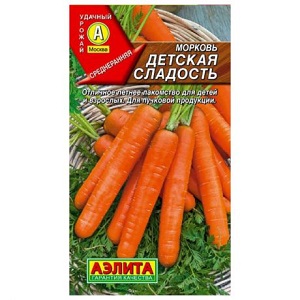 iron - 0.76 mg;
iron - 0.76 mg;- zinc - 0.37 mg;
- aluminum - 0.36 mg;
- manganese - 0.22 mg;
- boron - 0.23 mg;
- vanadium - 0.13 mg;
- copper - 0.72 mg;
- fluorine - 0.5 mg;
- molybdenum - 0.22 mg.
Vitamins in the composition (per 100 g):
- A - 0.97 mg;
- B1 - 0.07 mg;
- B2 - 0.07 mg;
- B8 - 0.32 mg;
- B9 - 0.12 mg;
- C - 0.7 mg;
- PP - 1.24 mg;
- E - 0.93 mg.
Root crops have a high content of carotene - provitamin A... In a child's body, it affects the growth and strengthening of bones, teeth, hair, and contributes to the health of the skin. The vitamins contained in carrots increase immunity and increase resistance to various infections.
Application features
Carrots Baby sweetness is one of the sweetest varieties... Due to its excellent taste, it is widely used in baby food in the form of bundled products, fresh juices, purees.It is widely used in cooking for the preparation of various vegetable stews, soups, salads.
Ripening period
Children's sweetness belongs to mid-season varieties. The period from emergence to full ripeness is 110-130 days.
Yield
Baby sweetness has a high yield: from 1 m², 4.5-6.8 kg of carrots are obtained. In some areas with favorable growing conditions, yields are reached at 7.5 kg per m².
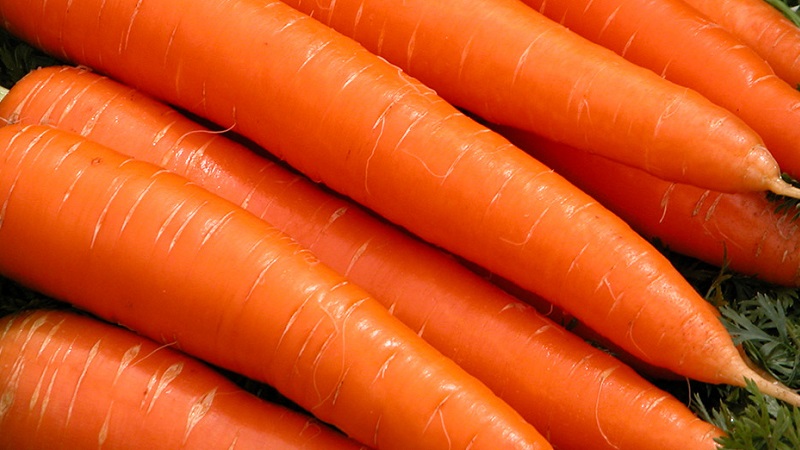
Disease resistance
Presowing seed treatment, soil disinfection after harvesting vegetables and in the spring before sowing can increase the resistance of the variety to many diseases and pests. It is not particularly resistant to certain diseases.
Characteristics, description of appearance, taste
Root vegetables varieties Children's sweetness bright orange in color, the core has a red-orange tint... The shape is cylindrical, with a rounded tip, weight - 100-140 g, length 12-18 cm. The rosette of the variety is semi-spreading, the tops are strong.
The taste of the variety is excellent, root vegetables with a high sugar content, crispy... Carrots have a high content of provitamin A. Due to their juiciness, the variety is widely used for making fresh juices.
For which regions it is best suited and what is the exacting climate
Variety recommended for cultivation in the Central Black Earth region of the country... It grows well in the Voronezh, Belgorod, Lipetsk, Kursk, Tambov regions.
For growing a variety and preserving its properties a temperate climate with a warm summer season is suitable and long frost-free periods during the winter.
The main advantages and disadvantages of the variety
The variety is characterized as:
 high-yielding;
high-yielding;- stem-resistant;
- having excellent taste and marketability;
- unpretentious in care;
- resistant to temperature drop down to -4 ° С;
- differs from other sweet varieties in a longer shelf life.
Disadvantages of the variety:
- exactingness to soil fertility;
- dependence of taste on the illumination of the site;
- the need for periodic hilling.
What is the difference from other varieties
From other varieties of culture Baby sweetness is different:
- higher levels of sugar and carotene;
- to maintain a high level of sugar and carotene, the variety requires constant good lighting;
- the variety grows well only on fertile soils.
Features of planting and growing
The variety is unpretentious in care... Subject to the conditions of agricultural technology, a correctly chosen land plot with a suitable soil composition, high yield rates can be obtained.
When growing varieties in temperate regions planting carrots before winter is allowed... With this method of cultivation, the crop is obtained 15-20 days earlier than with spring sowing.
Preparing for landing
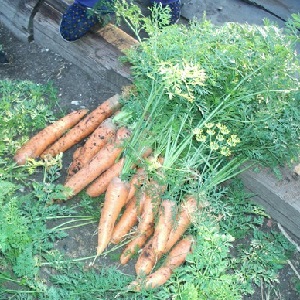 Only fresh seeds are taken for sowing... The germination rate of seed two or more years ago will be low.
Only fresh seeds are taken for sowing... The germination rate of seed two or more years ago will be low.
Seeds are pre-sorted, removing light, immature and damaged specimens. The remaining soaked for 2 hours in warm water... Empty, unusable seeds floating on the surface are discarded. The specimens that have sunk to the bottom of the container are removed and disinfected: a 3% solution of hydrogen peroxide is heated to 40 ° C and the seed is immersed in it for 15 minutes.
Then the seeds are germinatedwrapped in a cloth moistened with a solution of wood ash (1 tsp. ash per 1 liter of water). Then they are ready for sowing.
Attention! For podzimny planting seeds are not germinated.
Ground requirements
Carrots are demanding on the quality and composition of the soil... Loose, fertile soils are needed to grow the variety. If there is clay soil on the site, peat and humus are added to it when digging. If the soil is heavy turf, sand is added to it. If the acidity of the soil is overestimated, dolomite flour is added with digging.The variety grows well on loamy soils.
The soil is prepared in autumn... They remove all plant residues, dig deeply into the soil, while introducing potash and phosphorus fertilizers.
In the spring, before sowing, the site is loosened and dry wood ash is introduced.
Predecessors
When choosing a site for sowing carrots, particular importance is given to predecessors. The culture grows well if last season on this site grew legumes, grains, onions, garlic, cucumbers, potatoes, tomatoes. You should not plant carrots after parsley, dill, fennel, parsnips, as these crops and carrots have common diseases and pests.
Reference. Carrots are not planted on the same plot for two or more years in a row.
Timing, scheme and landing rules
Spring sowing is carried out in late April - early May, after the soil warms up to 8-10 ° C. In a previously prepared area, grooves are made 2 cm deep, watered with water. Seeds are spread to a depth of 1.5-2 cm at a distance of 2 cm from each other. The grooves are sprinkled with a small layer of earth, slightly pressing it down. A distance of 20 cm is left between the rows.
When sowing in winter, planting is carried out in late October - early Novemberwhen the air temperature finally drops to 5 ° С.
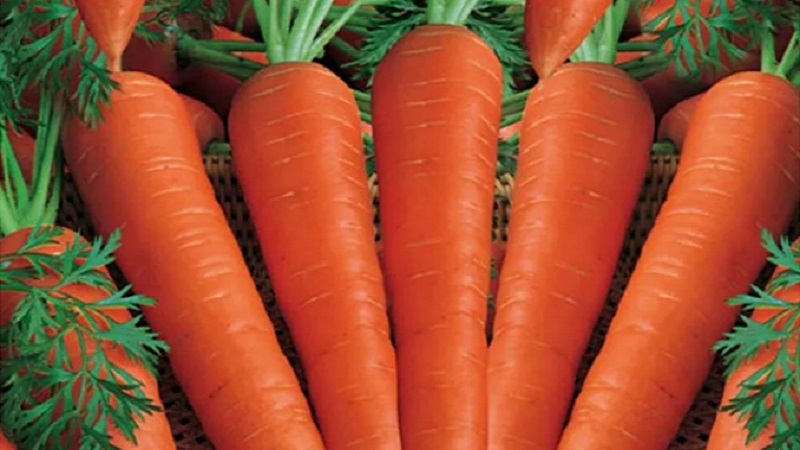
Growing features
For planting varieties, choose a sunny area with loose soil.... It is necessary to take into account the depth of the groundwater so that the roots are not in constant moisture.
Important! Waterlogging of the soil leads to the appearance of root rot.
Big attention is paid to constant loosening to prevent the formation of a soil crust.
Carrots sown before winter sprout 2-3 weeks earlier spring, therefore watering, loosening, fertilizing are also carried out earlier according to a scheme similar to the spring.
The nuances of care
When growing a variety, it should be borne in mind that Baby sweetness grows well in sunny areas and does not tolerate even light shade. With a slight darkening in root crops, the level of sugar and carotene decreases. In insufficiently lit areas, yield indicators also decrease.
Interesting on the site:
When to collect carrot seeds and how to do it
Watering mode
Before the emergence of shoots and when they appear, the soil is moistened every 3 days... Watering is carried out in the morning with a slight pressure of water so that the seeds are not washed out of the soil. As the plants grow, the abundance of watering is increased, while reducing their frequency to once a week. The soil should be moistened to a depth corresponding to the length of the root crops.
Important! Irrigation should be done regularly. Irregular watering with a large interval leads to cracking of root crops.
15-20 days before harvest watering is stopped.
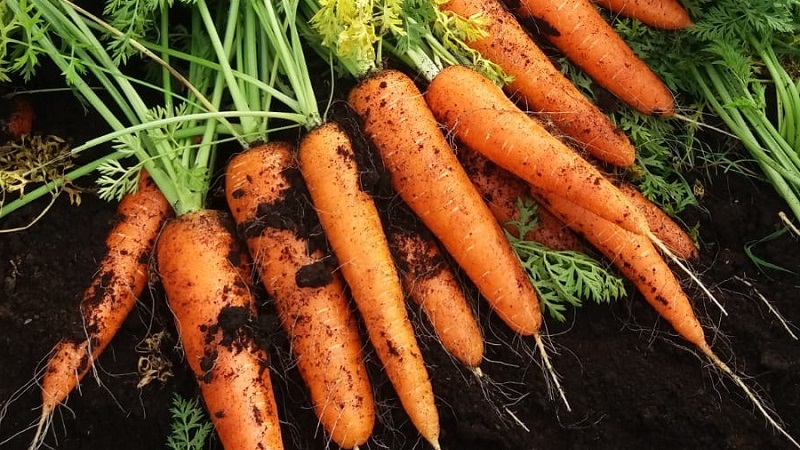
Thinning and weed control
The first thinning is carried out when two pairs of leaves will appear on the seedlings. A distance of 2 cm is left between the plants, removing undeveloped specimens. Then the procedure is repeated when the roots reach a diameter of 1.5-2 cm.In the end, a distance of 5-6 cm should remain between the plants.
Weeds are removed during thinning, since their active growth retards the development of vegetables.
Attention! All removed weeds and root crops after weeding and thinning must be removed from the site, as they will attract pests.
Top dressing
3 weeks after sprouting conduct the first top dressing urea: 20 g of the drug is diluted in 10 liters of water, watered at the root.
Important! Fertilizers are applied only to wet soil.
The second feeding is carried out 3 weeks after the first: potassium and phosphorus are added for the development of root crops. To do this, prepare a solution of 25 g of potassium nitrate, 30 g of "Superphosphate" and 10 liters of water. To feed the culture with potassium during the third procedure, a solution of wood ash is used: 400 g per 10 liters.
Disease and pest control
The most common cultural diseases:
- Fomoz - dry rot. Appears on the tops in the form of dry spots with a dark edging. The fungus then infects the roots. For prevention, phosphorus-potassium fertilizers are applied to the soil. Affected plants are treated with a solution of the preparations "Rovral", "Maxim".
- Alternaria - black rot. Yellow spots appear on the tops, the leaves curl, the fruits become covered with dry rot. At the first signs of damage, the plants are sprayed with the fungicide "Acrobat MC": 20 g of the drug are dissolved in 5 liters of water.
- Rhizoctonia - felt disease, recognized by the appearance of lead spots on roots, leading to decay of vegetables. Plants are watered with a solution of copper sulfate, prepared at the rate of 100 g per 10 liters of water.
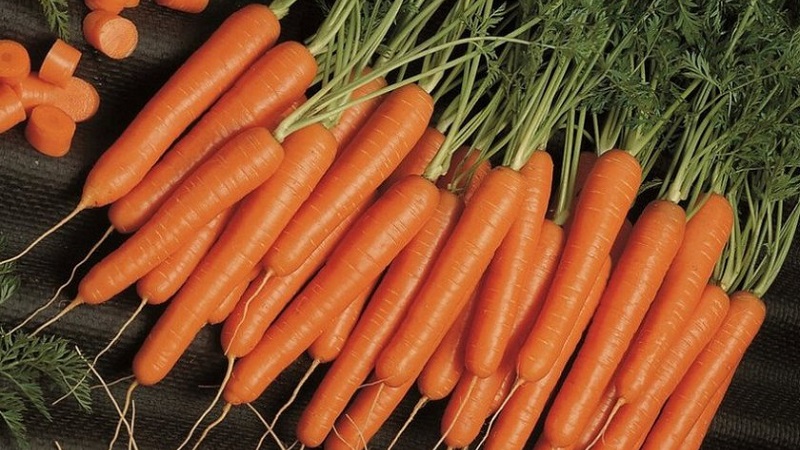
The main insect pest is the carrot fly... When it appears, the leaves acquire a reddish-purple hue and curl. Fly larvae feed on root vegetables. To combat carrot fly, use the drug "Inta-Vir": dilute one tablet of the agent in 10 liters of water, spray the plant. After 10 days, the treatment is repeated.
Dangerous for baby sweet carrots and bear - she lives in the soil, feeding on roots. The danger is posed by adults and their larvae, which, after birth, actively destroy root crops. To combat the bear, a composition is prepared from tincture of mustard, pepper and alcohol.
Harvesting and storage
Harvesting begins in late August - early September... Winter carrots ripen earlier. The degree of maturity of root crops is judged by the beginning of drying of the lower leaves on the tops. For harvesting, choose dry weather. The harvested vegetables are first sorted, dried, and then placed in winter storage.
How and when to collect
Vegetables are harvested in late summer - early autumn, at which time the roots stop growing.
Carrot gently pry with a pitchfork and pull it out of the ground by the tops, shaken off the ground and transferred to a dry room for drying.
After that, it is sorted. Intact, healthy specimens are taken for storage... Their tops are cut off and placed in winter storage. The rest are recycled.
Storage features and keeping quality of the variety
The vegetable storage creates optimal conditions for long-term storage of the crop. The air temperature should be maintained within 0 ... + 5 ° С, humidity - 90-95%... An increase in humidity leads to decay of root crops. The room must be constantly ventilated.
Properly stored keeping quality reaches 95%.
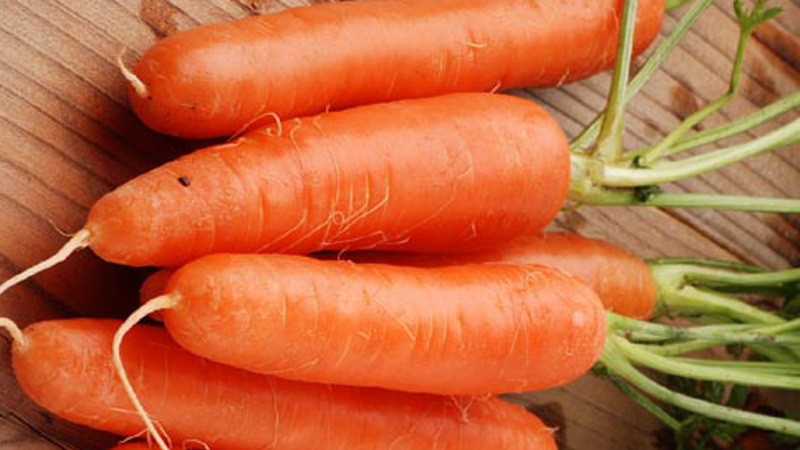
What can be the difficulties in growing
During the ripening process, the bases of the roots are shown above the soil level. The exposed areas turn green under the influence of sunlight. This indicates the formation of solanine... Because of its appearance, carrots begin to taste bitter and become unusable. To avoid this, it must be spilled regularly.
Tips from experienced gardeners
Experienced summer residents do not advise growing granular seeds, since constant abundant watering is required to dissolve the granule. Gardeners note the low germination of such seeds.
Many summer residents recommended to prevent plant thickening before sowing mix carrot seeds with sand in equal proportions.
Important! Experienced gardeners warn: do not water the plants abundantly after a long break - this will lead to cracking of the fruit.
Reviews of the variety of carrots Children's sweetness
About carrots baby sweetnessthere are only positive reviews among gardeners and farmers.
Olga, Tula: “The seller in the store advised the variety“ Children's sweetness ”. Liked the description on the package. I decided to try it. The baby carrot has grown very tasty and sweet. Even my grandchildren liked it ".
Irina, Vladimir: “Children love to nibble on thin young carrots. A neighbor in the country shared the seeds of Children's sweets.I liked the taste very much: sweet, crispy. The children really liked it ".
Sergey, Omsk: “I am growing a variety of carrots for children, especially for my granddaughter. She loves to crunch a young sweet carrot in summer. I liked the taste and shelf life ".
Conclusion
Carrots Children's sweetness is one of the most popular varieties of sweet carrots. The high content of sugar and carotene makes it suitable for baby food, juices and purees. The variety is easy to care for, well stored, grown for bunch production and fresh consumption.